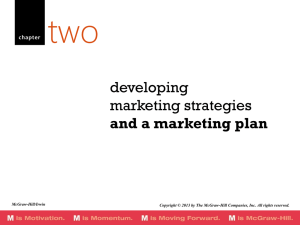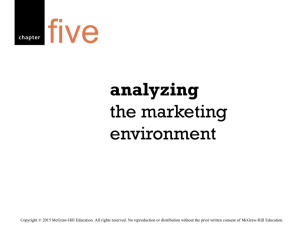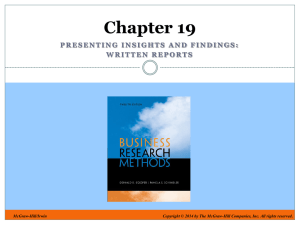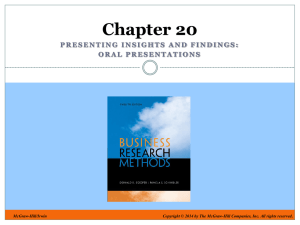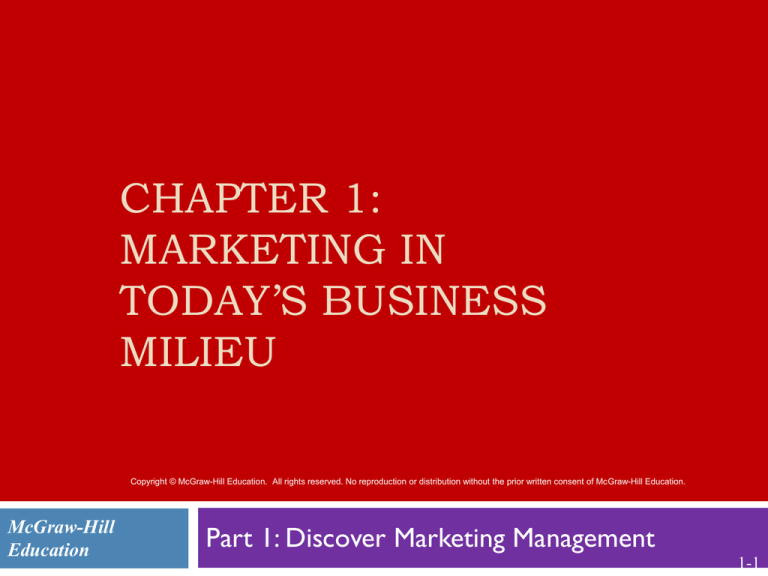
CHAPTER 1:
MARKETING IN
TODAY’S BUSINESS
MILIEU
Copyright © McGraw-Hill Education. All rights reserved. No reproduction or distribution without the prior written consent of McGraw-Hill Education.
McGraw-Hill
Education
Part 1: Discover Marketing Management
1-1
Learning Objectives
Identify typical misconceptions about marketing, why they
persist, and the resulting challenges for marketing
management
Define what marketing and marketing management really are
and how they contribute to firm success
Appreciate how marketing has evolved from its early roots to
be practiced as it is today
Recognize the impact of key change drivers on the future of
marketing
1-2
Welcome to
Marketing Management
Marketing is
relevant to
everyone across
all business
functions.
Marketing your
“personal brand”
helps you land a
job or promotion.
1-3
Marketing Misconceptions
Catchy and entertaining
advertisements
Pushy salespeople
Spam to your e-mail or
smartphone
Famous brands and their
celebrity spokespeople
Product claims that turn out to
be overstated or just plain false
Marketing departments “own”
marketing initiative
1-4
More Marketing Misconceptions
1.
2.
3.
4.
5.
6.
Marketing is all about advertising.
Marketing is all about selling.
Marketing is all about the sizzle.
Marketing is inherently unethical and harmful
to society.
Only marketers market.
Marketing is just another cost center in a firm.
1-5
Behind the Misconceptions
Marketing is Highly Visible by Nature
Advertising
and Sales Promotion seen by all
Marketing Metrics
Gauging
performance to drive results
“If it can’t be measured, it can’t be managed.”
Marketing is More Than Buzzwords
Often
viewed as a “necessary evil”
Too many quick-fix approaches
Need to position marketing as a respectable field
1-6
Toward the Reality
of Modern Marketing
Marketing is a central
function and set of
processes essential to
any enterprise.
Leading and managing
the facets of marketing
is a core business
activity.
1-7
DEFINING MARKETING
Peter Drucker, circa 1954
“There
is only one valid definition of business purpose:
to create a customer.….the business enterprise has
two—and only two—business functions: marketing
and innovation.
Peter Drucker, circa 1973
“Marketing
is so basic that it cannot be considered a
separate function (i.e., a separate skill or work) within
the business… It is the whole business seen from the
customer’s point of view.”
1-8
DEFINING MARKETING
“Marketing is the
activity, set of
institutions, and
processes for
creating,
communicating,
delivering, and
exchanging offerings
that have value for
customers, clients,
partners and society
at large.”
American Marketing
Association, 2007
1-9
Defining Marketing
Marketing’s Stakeholders
Internal
and External
Societal Marketing
Members
of society at large
are stakeholders
Green Marketing
Environmentally
friendly
Sustainability: Meeting needs
without harming future
generations
1-10
Core Marketing Concepts
Value is the ratio of the bundle of benefits a
customer receives from an offering compared to
the costs incurred by the customer in acquiring
that bundle of benefits.
Exchange occurs when people give up something of
value to them for something else they desire to
have.
1-11
For Exchange to Take Place
There must be at least two
parties.
Each party has something that
might be of value to the other.
Each party is capable of
communication and delivery.
Each party is free to accept or
reject the exchange offer.
Each party believes it is
appropriate or desirable to deal
with the other party.
1-12
Marketing’s Roots
and Evolution
Pre-Industrial Revolution
Focus on Production and Products
Focus on Selling
Advent of the Marketing Concept
Post-Marketing Concept Approaches
1-13
Pre-Industrial Revolution
Products were
customized
One-to-one
marketing
Production Orientation
Maximizing mass production via
assembly line
Assumes customers will go the
producer
“If you build it, they will come.”
Henry Ford: “People can have
the Model T in any color—so
long that it’s black.”
Sales Orientation
Salespeople need to push the product
Production
capacity increased post-WW1
New competitors flooded the market
More sophisticated financial markets pressured firms
to increase sales volume and profitability.
Created the image of the pushy salesperson
Marketing Concept
Post World War II
Pent-up
demand for consumer goods and services
Euphoric focus on family and getting back to normal
Increased production for consumer goods
Sophisticated marketing research enabled by
mainframe computers
Marketing concept spread in the 1960s and 70s
Led
to allowing the market to decide what products it
wanted which gave rise to marketing planning
Marketing Mix
Mid-1960s : The 4 Ps, or marketing mix
Product,
Price, Place, Promotion
Today: more sophisticated view of 4Ps
Products
are offerings; focus is on solutions
Place is complex supply chains
Price is viewed as value; Benefits/price
Promotion uses high-tech media
Beyond the Marketing
Concept
Differentiation Orientation
Market Orientation
Relationship Orientation
One-to-One Marketing
1-19
Beyond the Marketing Concept
Differentiation
Orientation
Clearly communicates
how the firms
products from
competitors
Market Orientation
Implementation of the
marketing concept
Customer Orientation
The
core
customer is at the
Beyond the Marketing Concept
Relationship Orientation
Focuses on customer
retention
CRM drives customer
satisfaction and loyalty
One-to-One Marketing
Advocates a learning
relationship so that
the firm can offer
customized products
and services
Mass customization
Levi’s allows customers to
order perfect fit jeans.
Change Drives Impacting The
Future of Marketing
Shift to product glut and customer shortage
Shift in information power from marketer to
customer
Shift in generational values and preferences
Shift to demanding return on marketing investment
Shift to Marketing (“Big M”) and marketing (“little
m”)
1-22
Shift to Product Glut and
Customer Shortage
The balance of power is shifting between
marketers and their customers, both in B2C and
B2B markets.
Not only is a customer orientation desirable, but
also in today’s market it is a necessity for survival.
1-23
Shift in Information Power
from Marketer to Customer
Customers of all kinds have nearly limitless access
to information about companies, products,
competitors, other customers, and even detailed
elements of marketing plans and strategies.
1-24
Shift in Generational Values
and Preferences
Impacts the firm’s message and the method by
which that message is communicated.
Impacts marketing in terms of human resources.
Generational changes are nothing new.
1-25
Distinguishing Between Marketing
(“Big M”) and marketing (“little m”)
Marketing (Big M)
Strategic
marketing, means a long-term, firm-level
commitment to investing in marketing – supported at
the highest organization level – for the purpose of
enhancing organizational performance.
marketing (little m)
Tactical
marketing, which serves
the firm and its stakeholders at
a functional or operational level.
1-26
Shift to Justifying the Relevance and
Payback of the Marketing
Investment
How can management effectively measure and
assess the level of success a firm’s investment in
various aspects of marketing has had?
1-27
Marketing Metrics
Marketing is a fuzzy field
If it can’t be measured, it can’t be managed
Is marketing an expense or an investment?
CEOs and stockholders expect marketing
accountability
1-28
Photo Credits
Slide 1-3 Digital Vision/Punchstock
Slide 1-4 Geoff Manasse/Getty Images
Slide 1-7 Purestock/SuperStock
Slide 1-9 #1 Monty Rakusen/Getty Images, #2 McGraw-Hill Co. #3Tom Grill/Corbis, #4
Comstock Images/Alamy
Slide 1-12 Purestock/SuperStock
Slide 1-14 Fototeca Storica Nazionale/Getty Images
Slide 1-15 Library of Congress Prints & Photographs
Slide 1-21 The McGraw-Hill Copanies, Inc/John Flournoy
Slide 1-24 Vstock LLC/Getty Images


